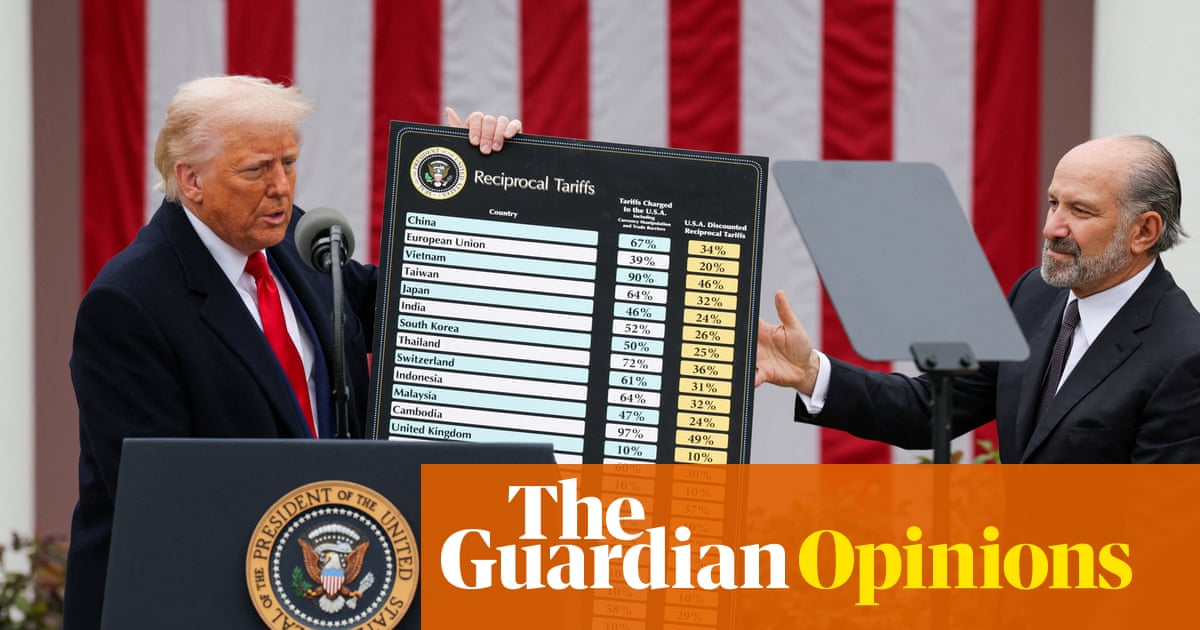In nearly 100 days on the job, Donald Trump has outlasted Liz Truss and afabled head of lettuce. That’s a fact, not an achievement. Like the hapless British prime minister, the 47th president blazes a trail of wreckage. Chaos is his calling card. If, when and how the carnage ends is anyone’s guess.
The US simultaneously wages economic war on its allies and China. Tariffs soar. It’s as if Trump forgot the words “Smoot-Hawley” and “Great Depression”. The president risks higher inflation and a recession for an idealized yesteryear that never quite was. Back on Earth, markets signal potential capital flight and stagflation.
Meanwhile, the possibility of China invading Taiwan has moved beyond speculation. The US loses Asia. During his first term, Trump’s team included seasoned China hawks. They grasped the magnitude of the threat Beijing posed to the US. They also understood that resistance necessitated building relationships, steadily and strategically. Not any more.
Instead,Peter Navarro, convicted of contempt of Congress, helps his bossshape US trade policy. Together, they damage America’s global standing. Meanwhile Scott Bessent, the treasury secretary, acts like a nine-figure bystander instead of the hedge fund god he once was. Marco Rubio, Trump’s secretary of state, looks like a prisoner in a hostage video.
Reality bites. The US dollar sinks while interest rates rise, a phenomenon generally associated with developing-world economies, not with the home of Wall Street and Silicon Valley. Trump brings his own systemic risk.
The stock market gyrated downward when he attacked the independence of the Federal Reserve and demanded theouster of its chairman, Jerome Powell. Trump branded him a “major loser” and as “Mr Too Late”. Along the way, Trump jeopardizes the reserve currency status of the US dollar. Russia and China could not have asked for a better friend.
Trump also threatens Canada, Denmark and Greenland with invasion or annexation.
Backlash from across the border is real. “There is no going back,” the Liberal leader, Mark Carney, concedes. “President Trump is trying to fundamentally restructure the international trading system and, in the process, he’s rupturing the global economy.” Fewer Canadians travel southward. “Elbows up”, a hockey metaphor, morphs into a rallying cry.
Trump’s latest tenure is already consequential. Almost daily, the administration takes a sledgehammer to America’s institutions and constitution. When Trump is only left withClarence Thomas and Samuel Alito in his corner, as he was over a planned mass deportation, he has gone too far. By contrast, the Trump appointees Neil Gorsuch, Brett Kavanaugh and Amy Coney Barrett knew better.
Likewise, when Trump loses J Harvie Wilkinson – a Reagan-appointed appellate judge and staunch conservative – over “due process” concerns, America stands in uncharted territory. “This should be shocking not only to judges, but to the intuitive sense of liberty that Americans far removed from courthouses still hold dear,” Wilkinson wrote.
During the 2016 campaign, Paul LePage, then governor of Maine, thought Trump might need to show some “authoritarian power”. Joe Sitt, a major player in New York real estate and an early Trump backer,chimed in: “We don’t have a president. We have a king.”
Nine years later, Trump and his minions don’t mind the analogies. The president speaks of deporting US citizens and bludgeons major research universities. Much of his base eagerly nods.
Trump’s current cabinet and White House staff are more sycophantic than in his first term. Fewer guardrails inhibit him. Generals John Kelly and HR McMaster no longer inhabit the West Wing. Rather, acolytes, novitiates and lackeys surround him.
Loyalty über alles.
Peter Hegseth, the current defense secretary, is exhibit A. In 2016 he lambasted Hillary Clinton for her email. “Any security professional, military, government or otherwise, would be fired on the spot … and criminally prosecuted for being so reckless with this kind of information,”he told Fox News.
Nine years later, Hegseth shares US war plans with friends and family over less than secure channels and resents the resulting scrutiny.Trump offers his endorsement: “He’s doing a great job.” Or not. John Ullyot, who resigned after serving as a defense department spokesperson,called the situation at the Pentagona “full-blown meltdown”.
“It’s been a month of total chaos at the Pentagon,” Ullyot explained. “From leaks of sensitive operational plans to mass firings, the dysfunction is now a major distraction for the president – who deserves better from his senior leadership.”
Years back, Steve Bannon, Trump one-time campaign guru and pardon recipient, mused to the author Jeremy Peters that Trump would “end up going down in history as one of the two or three worst presidents ever”.
“It’ll be James Buchanan, Donald Trump and Millard Fillmore,”Bannon is quoted as saying, in reference to two presidents of the 1850s who failed to stop the slide to civil war.
The other day, Senator Lisa Murkowski of Alaska confessed to being scared of Trumpian retaliation. “We are all afraid,”she said.
“It’s quite a statement. But we are in a time and a place where I certainly have not been here before. And I’ll tell ya, I’m oftentimes very anxious myself about using my voice, because retaliation is real. And that’s not right.”
Come 4 July 2026, the US will mark its 250th birthday. By then, Trump will have been in office for almost 18 months. Imagine how much more he will have accomplished. And destroyed.
Lloyd Green is an attorney in New York and served in the US Department of Justice from 1990 to 1992
